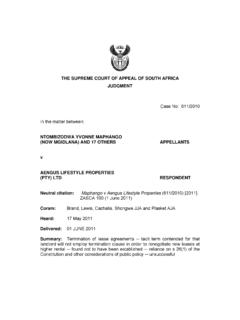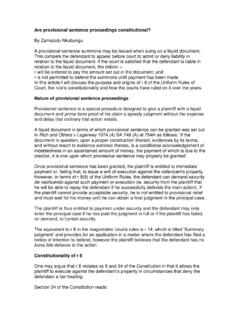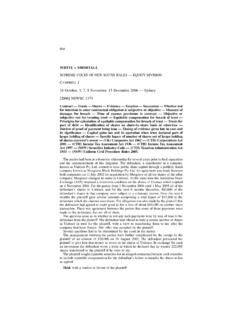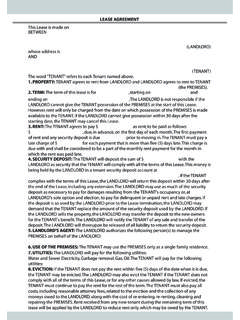Transcription of Indemnity Wars: Anti-Indemnity Legislation Across …
1 Indemnity wars : anti -IndemnityLegislation Across the Fifty StatesDean B. Thomson and Colin Bruns*In their broadest form, construction Indemnity agreements areessentially a promise by which one party (the indemnitor) agreesto defend, indemnify, or hold harmless another party (theindemnitee) for acts or omissions relating to a constructionproject. Sometimes the indemnitee calls on the indemnitor topromise Indemnity even for the indemnitee's own , indemnitors typically complain about beingasked to indemnify beyond their own fault, and the common lawtends to narrowly construe the scope of Indemnity agreementsthat are not based on fault.
2 Most state legislatures have alsodeclared that certain types of indemnities not based on fault areagainst public policy and invalid. Hundreds of cases address theenforceability of Indemnity agreements, and all but a few stateshave statutes on this subject, demonstrating that the battle overwhether and how one party should indemnify another on aconstruction project is constantly being fought. The struggle be-tween the demands of indemnitees and the reluctance of indemni-tors continues apace, and this article is intended to provide areport from the legislative battle not only concerns Indemnity agreements; it alsoextends to the allowable scope of requiring one party to insureagainst the fault of another.
3 There is truth in the old saw that the Indemnity is only as good as the indemnitor, so manyindemnitees attempt to secure the indemnitor's indemni cationpromise by requiring that the indemnitor procure contractual li-ability coverage as part of the indemnitor's commercial generalliability ( CGL ), which among other things is intended to insurethe indemnitor's contractual Indemnity promise. Although statusas an additional insured is di erent from insurance covering aseparate contractual Indemnity , many upstream indemniteesalso contractually require that they be named as an additional*Dean Thomson is a Fellow in the American College of ConstructionLawyers and a shareholder in the Minneapolis, Minnesota law rm ofFabyanske, Westra, Hart & Thomson, Colin Bruns joined the rm as anassociate in the fall of 2014.
4 The authors would like to thank Peter Doely, alsoan associate with the rm, for his research Thomson ReutersEJournal of the ACCLEVol. 8 No. 2insured on the indemnitor's CGL policy. Although these two typesof coverages provide a similar scope of protection, there are sev-eral distinct advantages in being named an additional insured inaddition to those that an indemnitee receives with only contrac-tual liability of the same states that legislatively invalidate clausespurporting to indemnify another party for its own fault neverthe-less allow agreements to procure insurance that e ectivelyprovide the same kind of protection.
5 In these jurisdictions, agree-ments to insure another party against its own fault may be en-forceable even though a separate indemni cation agreementcovering the same would not. More recently, in response to lobby-ing from downstream indemnitors, several state legislatures havebegun to prohibit not only Indemnity agreements covering anindemnitee's fault, but also agreements to provide insurancecoverage for another party's fault. The result is a nationalpatchwork of varying common and statutory laws that, depend-ing on the jurisdiction applicable to the claim, may or may not al-low Indemnity agreements or agreements to provide insurancecovering another's those companies and their attorneys who practice inmultiple jurisdictions, this article is intended to o er a guidethrough the current maze of di ering state 1willreview the status of Legislation a ecting Indemnity agreementsamong the 50 states.
6 Section 2will consider the e ects of legisla-tion regarding agreements to procure contractual liability andadditional insured coverages; andSection 3will provide somepractical suggestions on how to best manage contractual risktransfer in the context of these varying laws. The appendicescontain charts and maps summarizing and citing to existing Anti-Indemnity statutes and important cases considering Indemnity Agreements GenerallyOne of the most common ways to allocate liability is throughan Indemnity agreement requiring one party to defend and reim-1 Contractual liability coverage extends to the insured (and only theinsured) if an insured contract exists.
7 It does not make the other party aninsured nor does it provide the other party with any independent rights to or aclaim against the insured's policy. Coverage is limited to damages and damagesare de ned to include defense costs which are thereby included in and limitedby the policy's coverage limits. Additional insured coverage, on the other hand,arises through an endorsement which provides that the other party is an insuredunder the policy and has independent rights to and a direct claim against thepolicy.
8 Defense costs under additional insured coverage are not limited by thepolicy's generallyBruner & O'Connor Construction Law 11 of the ACCL2 Thomson ReutersEJournal of the ACCLEVol. 8 No. 2burse another against certain losses or expenses. Generallyspeaking, there are three di erent forms of Indemnity : (1) broadform, which includes the sole negligence of the indemnitee; (2) in-termediate form, which includes all but sole negligence of theindemnitee; and (3) limited form, which includes only thenegligence of the , the vast majority of stateshave Legislation establishing which types of Indemnity agree-ments are allowed and which are the most basic level, each state legislatively generally treatsindemnity agreements in one of the three following ways: (1) thestate does not have an Anti-Indemnity statute.
9 (2) the state hasan Anti-Indemnity statute that prohibits an indemnitor fromindemnifying an indemnitee for the indemnitee'ssolenegligence;or (3) the state prohibits an indemnitor from indemnifying anindemnitee foranyof the indemnitee's own negligence, sole orpartial. Given the prevalence of Indemnity agreements inconstruction contracts, it is imperative for contracting parties tobe familiar with the relevant state's statutes on Indemnity , asthey can have a substantial impact on how the agreement States with No Anti-Indemnity StatuteWhile the vast majority of states in the United States havesome form of Anti-Indemnity Legislation for construction contracts,there are currently eight states that have no such statute.
10 Orhave a provision that only applies in limited circumstances: Ala-bama, Maine, Nevada, North Dakota,3 Pennsylvania,4 Vermont,Wisconsin,5and Wyoming6have all resisted the trend to enact ananti- Indemnity statute in the construction context. However, thatdoes not mean that any and all Indemnity agreements are neces-2 See generallyBruner & O'Connor Construction Law 10 Dakota does not have a general Anti-Indemnity statute for construc-tion contracts. However, of the North Dakota Century Code providesthat a provision in a construction contract which would make the contractor li-able for the owner's negligence is does not have a general Anti-Indemnity statute for construc-tion contracts, but it does have a statute that prohibits the Indemnity of designprofessionals.




